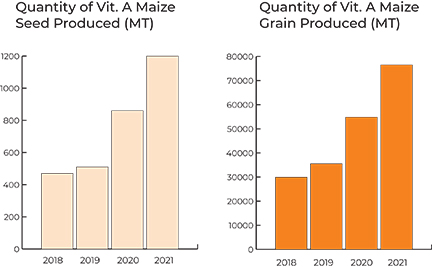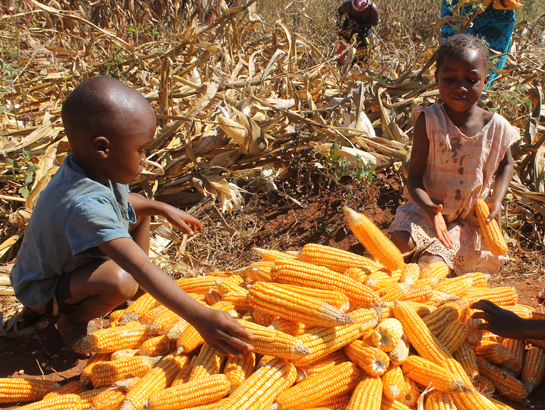A brief from the CGIAR’s HarvestPlus biofortification program describes how HarvestPlus has worked with multiple partners in Zambia to catalyze development and delivery of yield-competitive varieties of hybrid maize that are enriched with vitamin A.
The first three vitamin A maize (VAM) seed varieties were released in Zambia in 2012, followed by another three in 2015, and five more in 2018. Successive varieties have had improved nutrition and agronomic traits. The principal aim of the Zambia VAM program is to address high rates of vitamin A deficiency in the country—particularly among children and women—and the serious health problems it causes, including vulnerability to infections such as diarrhea, sight impairment, and poor pregnancy outcomes.
Production of both VAM seed and grain has been growing steadily in recent years despite logistical and economic disruptions from the COVID-19 pandemic.

HarvestPlus is catalyzing growth in VAM production and consumption through a holistic food systems-based approach focused on commercialization of VAM. This includes capacity strengthening of national agricultural research and extension programs as well as seed and food value chain actors; raising awareness and changing behavior among farmers and consumers; and risk-sharing mechanisms to drive
market development.
A key success factor on the supply side has been a significant reduction in the time to advance from seed development to market introduction, primarily by fostering collaboration in the process between public breeding institutions and private seed companies.
HarvestPlus also facilitated mechanisms to distribute seed and know-how to hard-to-reach farming households who are not readily serviced by commercial seed companies—for example, through women farmers’ groups and school feeding programs.
On the demand side, a variety of behavior change activities sensitized Zambians to accept and demand orange-colored maize in a market dominated by white maize, and amid negative perceptions associated with colored (yellow) maize at the time of introduction.
In addition, effective engagement of decision makers catalyzed supportive policy and regulatory reforms, and high-level championing of biofortification.
HarvestPlus is currently looking to accelerate VAM growth through a proven food-basket biofortification approach, which is aligned with government and funder priorities. HarvestPlus is promoting VAM in tandem with iron-biofortified bean and vitamin A-biofortified orange sweet potato (a high iron bean variety was released in 2012, while eight varieties of vitamin A orange sweet potato (OSP) have been released since 2014).
Orange VAM and other biofortified crops are now widely accepted products and poised for scaling in Zambia, if given the right support. To achieve increased impact and long-term sustainability, more investment is needed to fully mainstream nutrient targeting in Zambia’s crop breeding system, and engage more private sector actors in seed and food value chains to increase the uptake and help address malnutrition.
Contact HarvestPlus for more information about our work to scale biofortified crops and foods in Zambia and elsewhere in Africa and Asia.
